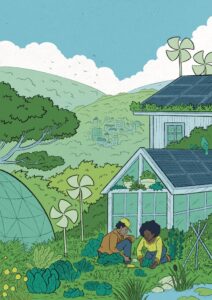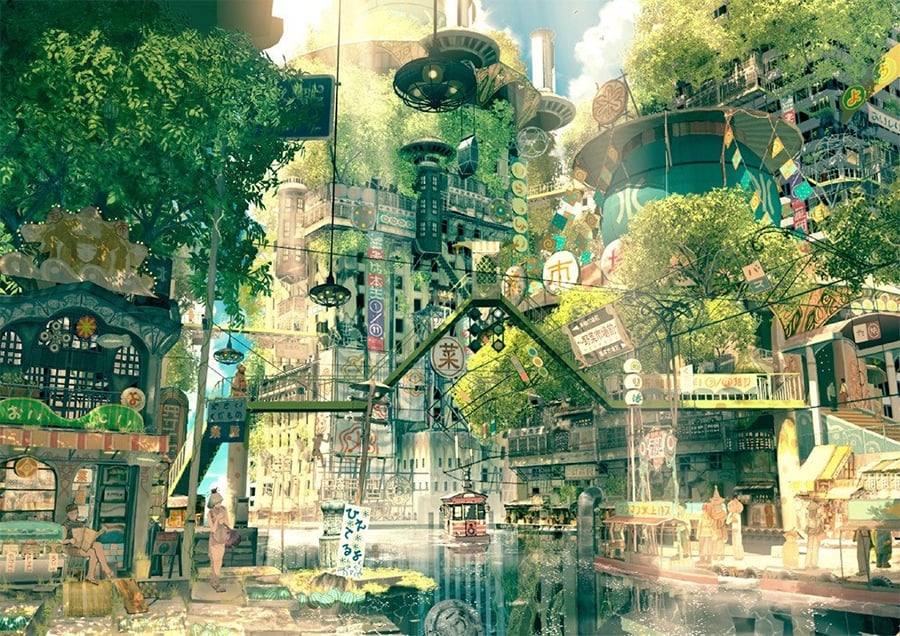
Session Summary:
We opened by asking some thought-provoking questions;
- Who here is worried about climate change?
- Who is worried about their home-town?
- Who is worried about future children?
- Who is worried it’s too late to save the planet?
We heard different responses from the crowd, but many themes were shared. People were scared, uncertain, and in many cases, outright pessimistic. Because pessimism has become such a pressing issue in our times, we wanted to focus on the importance of hope, and how we can envision a positive future together, as a basis for collective action. In this vein, we moved from climate doomerism to talking about the history of early Utopian Socialist thinkers:
Francois Marie Charles Fourier, coiner of the term Feminism, who developed communal spaces for people called “Phalansteres”, where space was shared with the old and young alike, and gender roles were not pushed in any rigid manner.
Robert Owen, founder of the British Cooperative movement, who developed ways in which workers could own their labour within even the capitalist market, and attempted to create circular economies.
William Morris, founder of Morris prints, who attempted to find ways in which nature was not dominated by capital, and all humans had a right to not just materially good lives, but fulfilling and beautiful ones as well.
We discussed briefly how these thinkers, though influential, ultimately did not succeed in fundamentally changing how we live.
Finally, we discussed the more recent influence of Murray Bookchin and his Social Ecology, a utopian idea of a world where people choose to live in cooperation with nature, not dominate it, in a way that is non-hierarchical.
After the break, we discussed what Solarpunk is, and how it came to be.
To quote Andrew of the YouTube channel Andrewism:
“Solarpunk is a shining vision of a positive future, grounded in our existing world, that emphasizes the need for environmental sustainability, self-governance, and social justice. It’s a movement dedicated to human-centric and eco-centric ends. It looks beyond the limitations of capitalism and beyond the current rift between humanity and nature. It’s a futurism that focuses on what we should hope for rather than on what to avoid. Solarpunk recognizes that climate change, the consequences of centuries of damage, aren’t averted in the future. Yet it still manages to incorporate hope. A future where we’ve got a lot of work to do, but we’re doing better. We’re using technology for more uplifting ends. Like seed bombing drones and solar ovens. Solarpunk emphasizes real-world application. It’s all about what we do here and now, from DIY projects to larger organization. Solarpunk is also very aesthetic, as I’m sure you’ve realized. It uses a lot of nature motifs and takes inspiration from art nouveau, upcycling, and Asian and African styles and artistic movements.”
After defining the idea, we checked out some examples of Solarpunk art, like this video that was originally a Chobani ad XD. Now that we had some of the Solarpunk aesthetics in mind, we walked through a brief history of where Solarpunk originated and spread (spoiler: it mostly sprang out of tumblr!):
Solarpunk, as far as anyone can remember, began with a post in 2008 on the blog Republic of the Bees called “from Steampunk to Solarpunk”. The author was inspired by a real world cargo ship called the Beluga SkySail, which uses a giant sail to increase its fuel efficiency. This reminded them of a science fiction book called “Songs From the Stars” by Norman Spinrad, which “is built around the idea of a technologically-sophisticated society which restricts itself to four, renewable forms of energy: muscle, sun, wind, and water.”
This combination of past technology with future society, reminded the author of Steampunk – a world of technology before oil – to speculate about Solarpunk – a world of technology after oil.
In 2009, Matt Staggs, a literary critic, introduced the idea of “Greenpunk”:
“Like steampunk, GreenPunk would focus on and celebrate alternative technology, but specifically as it relates to people using up the remnants of consumer culture to create a civilization that embraces recycling, upcycling and an ecologically friendly philosophy.”
In 2013, Solarpunk got its first inklings of utopian politics when the tumblr page “solarpunks” posted On the Need for New Futures, an essay arguing for utopian art as a catalyst for social change:
“One of the most curious facts about living as we do today is that our future does not, strictly speaking, exist. […] Setting aside all the wonderful, promised technologies beating down our door, let’s be real about the fact that at least some of the following Bad Things will probably happen in the next century: dwindling fossil fuels, climate change and its attendant catastrophes, crises in water supplies, rampant antibiotic resistance, global pandemics, overpopulation, and black swans birthed from unceasing societal acceleration. […] The promises offered by most Singularity-boosters and Transhumanists are ultimately individualist, unsustainable, and selfish […] We are starved for visions of the future that will sustain us, and give us something to hope for, ideas of life beyond the rusted chrome of yestermorrow or nightmare realms of radiated men eating the flesh of other radiated men. […] Our futurism is not nihilistic like cyberpunk and it is not quasi-reactionary a la steampunk–it is about ingenuity, positive creation, independence, and community. […] Neal Stephenson has introduced the idea of the fictional vision acting as a “hieroglyph,” allowing large teams to collectively envision the Big Future they’re bringing into existence. We need these Big Futures in new directions, towards things beyond cool toys for rich people.”
2014 was the year when Solarpunk really exploded into broader popularity, as the tumblr user Miss Olivia Louise posted some of its most famous concept art on her blog, remarking that :
“But what I want to see is Solarpunk – a plausible near-future sci-fi genre, which I like to imagine as based on updated Art Nouveau, Victorian, and Edwardian aesthetics, combined with a green and renewable energy movement to create a world in which children grow up being taught about building electronic tech as well as food gardening and other skills, and people have come back around to appreciating artisans and craftspeople, from stonemasons and smithies, to dress makers and jewelers, and everyone in between. A balance of sustainable energy-powered tech, environmental cities, and wicked cool aesthetics. “

In that same year, Adam Flynn posted “Notes toward a Manifesto” on Project Hieroglyph (the same project started by Neal Stephenson that “solarpunks ” referenced a year before!), arguing that:
“We’re solarpunks because the only other options are denial or despair. […] And yes, there’s a -punk there, and not just because it’s become a trendy suffix. There’s an oppositional quality to solarpunk, but it’s an opposition that begins with infrastructure as a form of resistance.”
We finished our little history lesson by turning our attention to what we can do here in Amsterdam in the here and now to create our own solarpunk city. We brought up the ideas of:
- guerrilla gardening,
- seed bombs, including a few guides to making your own!:
- permaculture gardens like
- Terracotta cooling for zero-carbon climate control in the home. You can see some inspiring examples coming out of a neat design firm in Delhi, CoolAnt.
- The housing estate of Galgebakken, and the importance of adequate green spaces in the concrete deserts we call our cities, and how broad climate change alone is not the only climate threat that we face when we do not properly learn to live with the natural environment we exist in.
Finally, we ended the session with suggestions and visions of what people’s own Utopia would look like, from better neighbourhood connections, to more sharing of responsibilities, to being more collective and community oriented, to working with the environment, and towards a future we would want to actually live in.
Learn even more about Solarpunk!:
Readings
Podcasts
Videos


